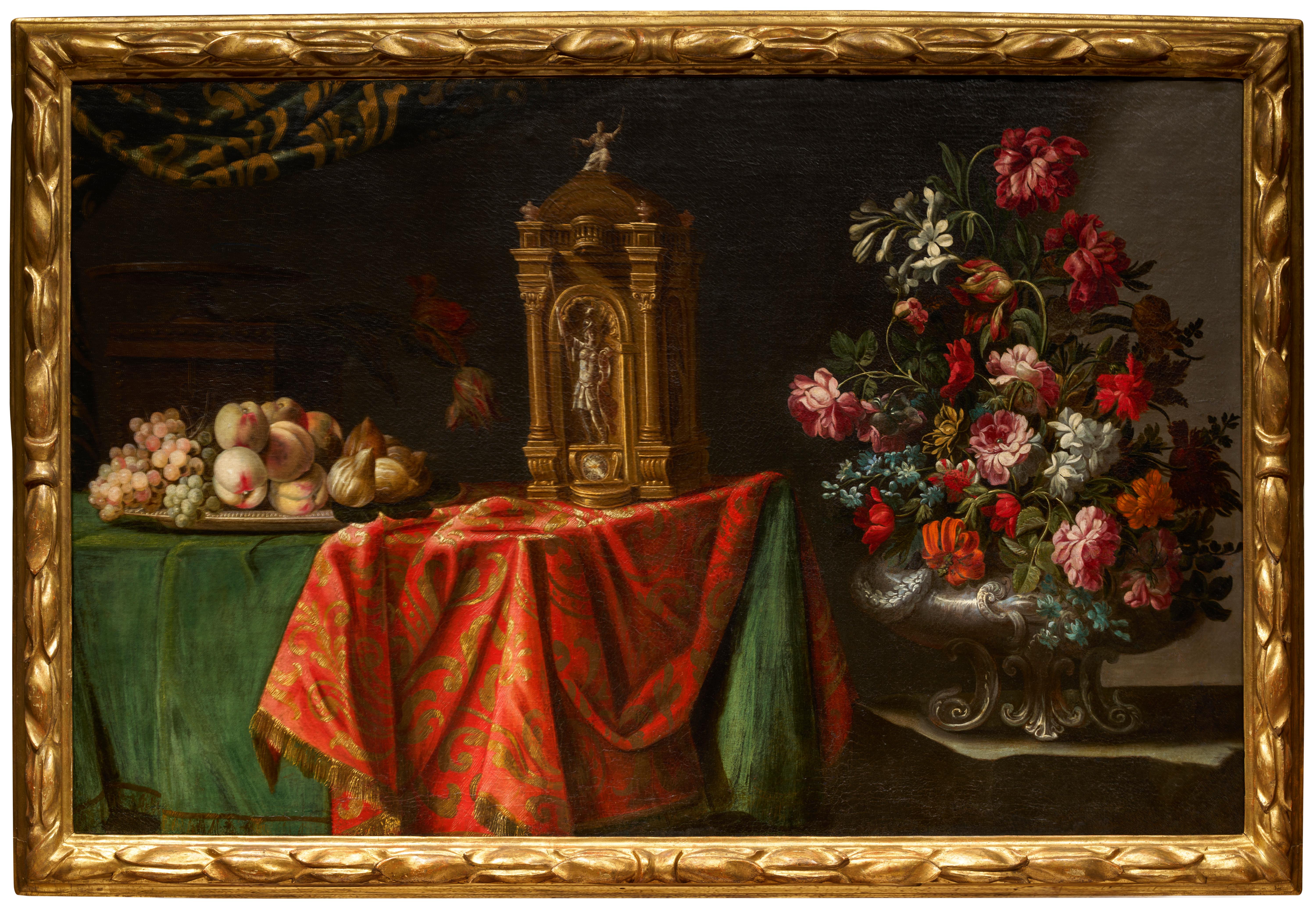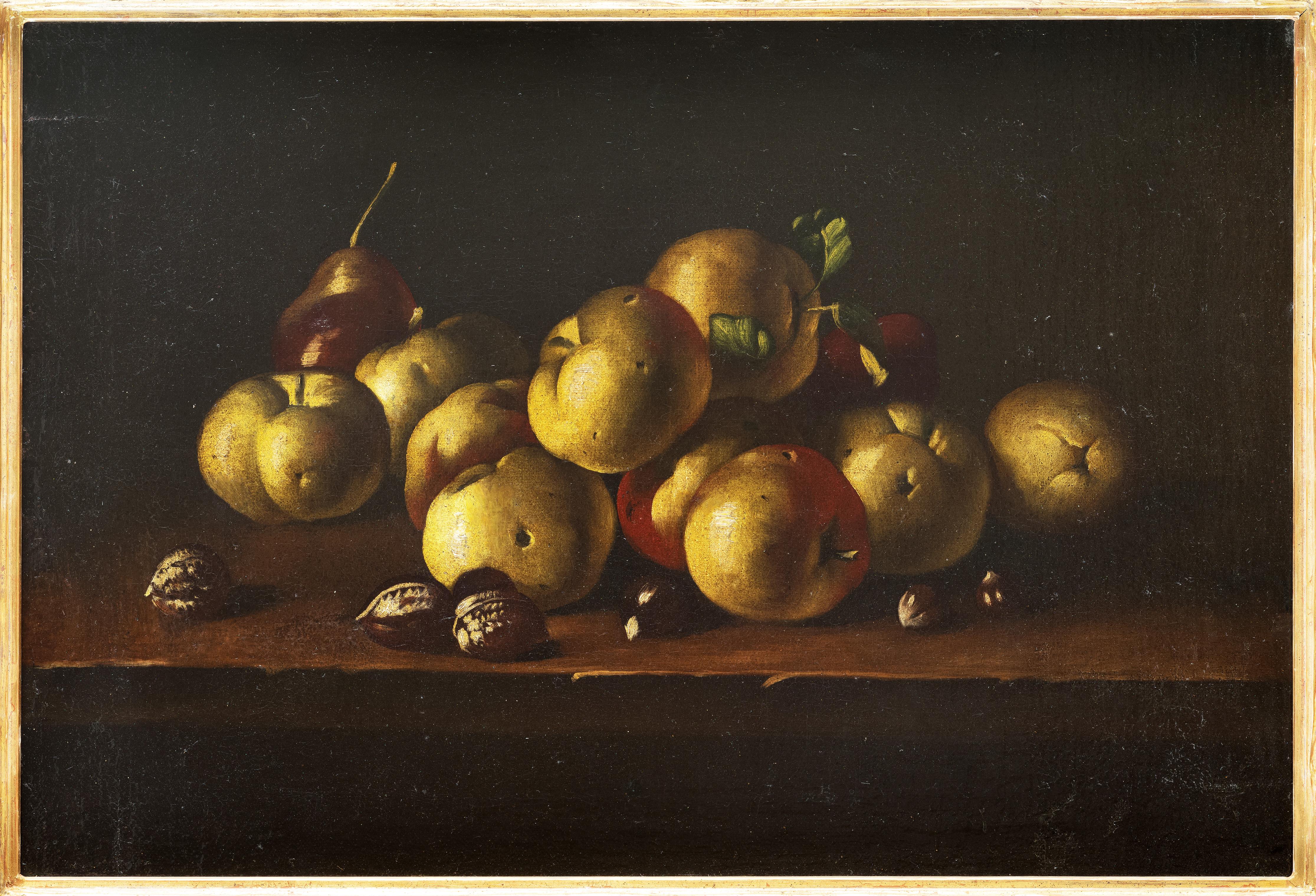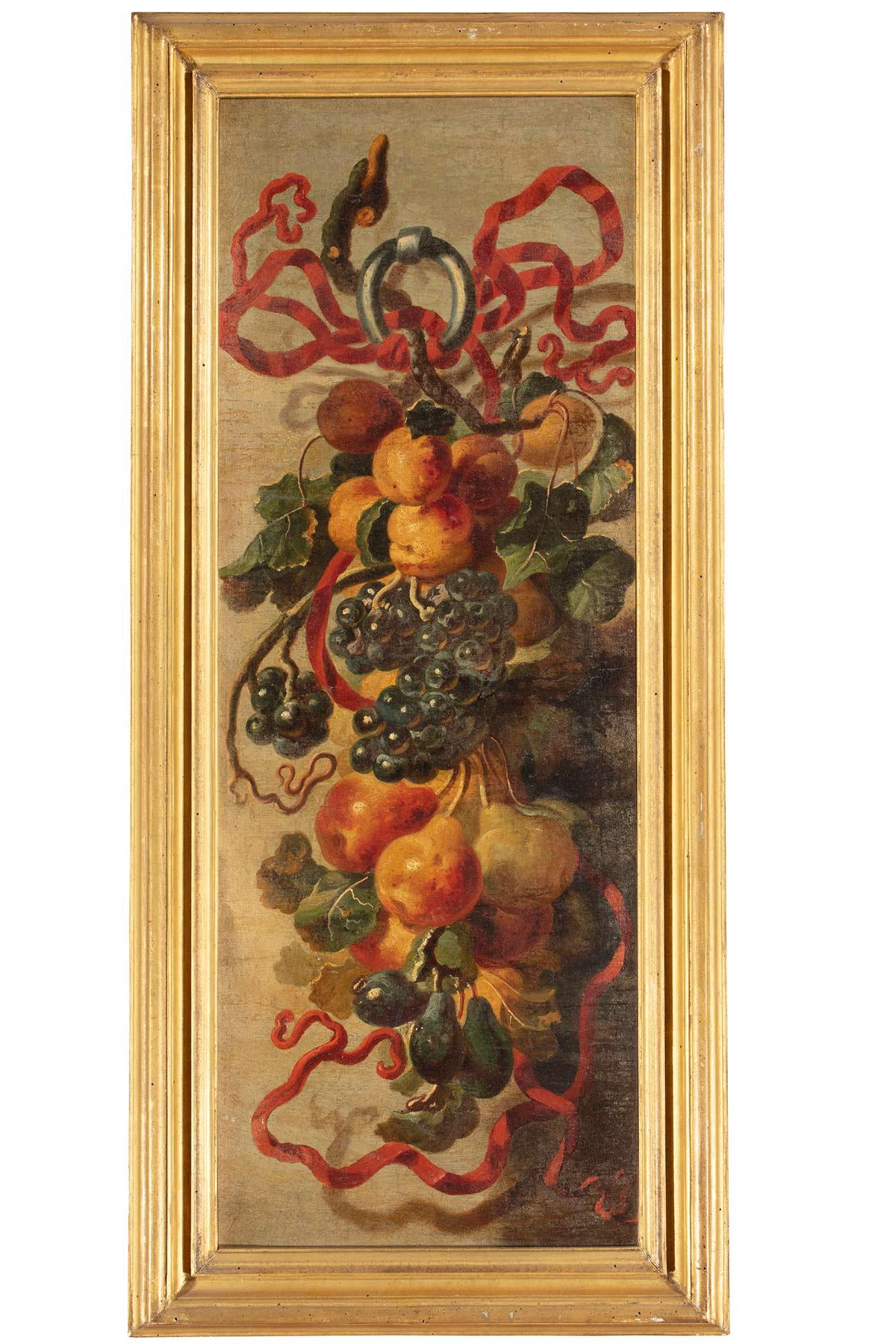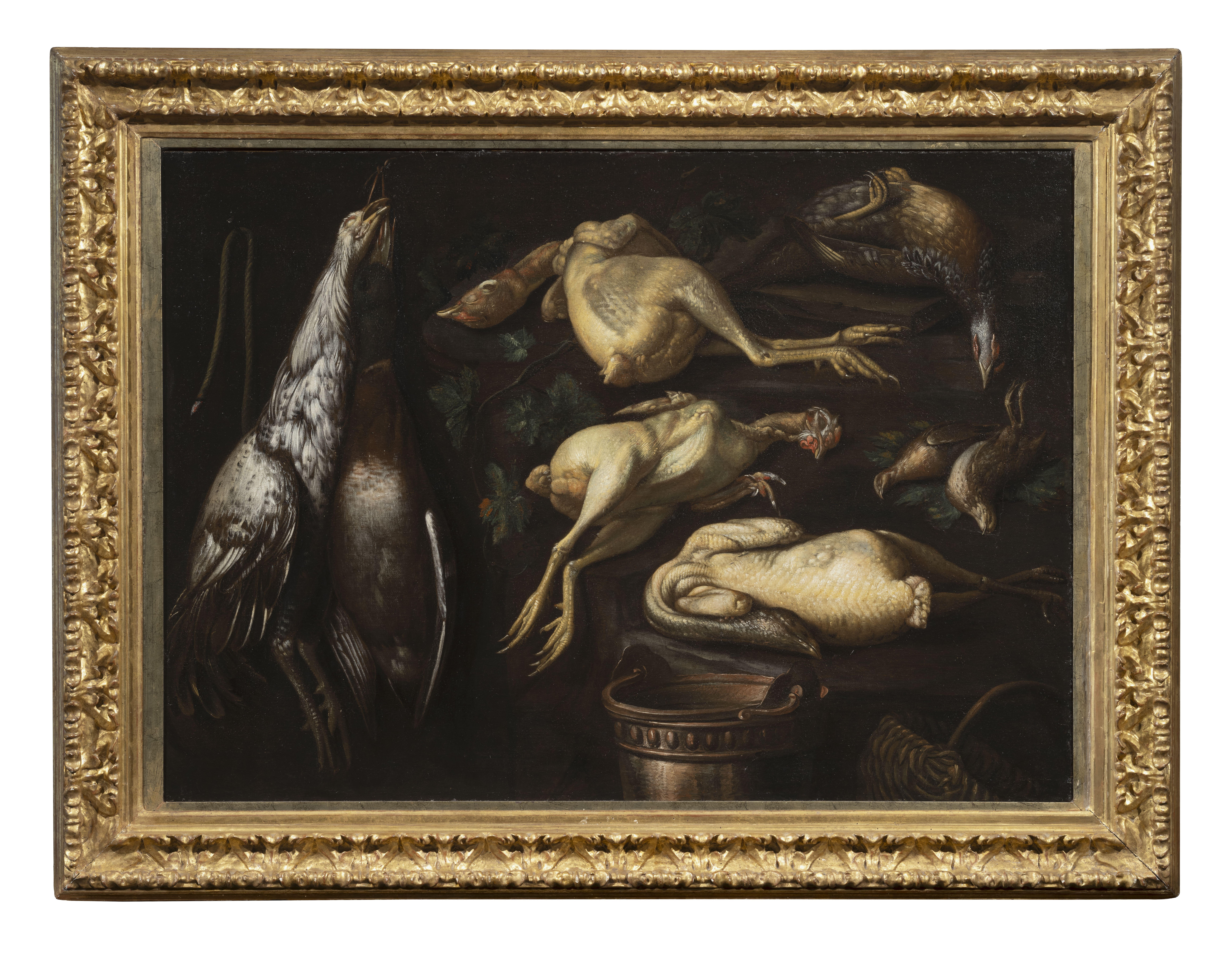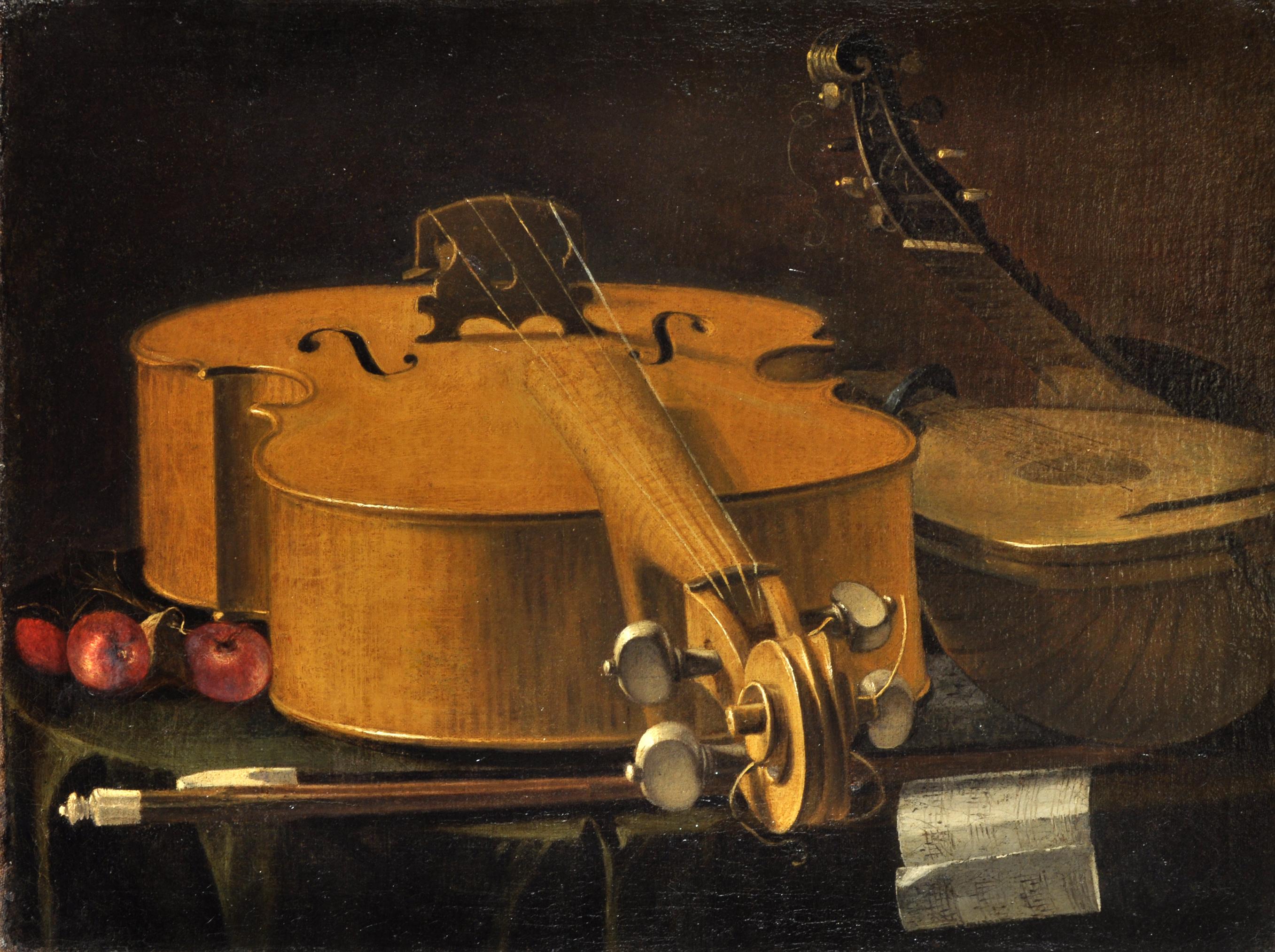Items Similar to Flowers Paint Oil on canvas Old master 17th Century Italy Still-life Art
Want more images or videos?
Request additional images or videos from the seller
1 of 24
Flowers Paint Oil on canvas Old master 17th Century Italy Still-life Art 1600-1650
1600-1650
About the Item
Master of the Grotesque Vase (active in Rome and Naples in the first quarter of the 17th century)
Still life of flowers in a classic vase
oil on canvas
66 x 51 cm, In frame cm. 82 x 68
In this sumptuous still life we see a precious classical vase in partly gilded and embossed metal, animated by two protruding harpies with the function of handles, which collects a fine floral bouquet inside. Next to the vase, placed on a stone shelf, two small birds arranged symmetrically one in front of the other.
The elaborate artifact, protagonist as much as the floral varieties it contains, has a whimsical and bizarre shape, which is inspired by the features that are still late Mannerist. All evoke the magnificent studies of vases carried out, between the sixteenth and seventeenth centuries, by Polidoro da Caravaggio.
The shape and decoration of our vase reflect a very popular model in the seventeenth century, which art historians have brought together under the name of "Masters of grotesque vases". With this name a number of authors are grouped, probably active in different territories of Central Italy, mainly Rome and Naples, but also in the North, over a period of time extended during the seventeenth century. It is a rather archaic production of paintings, also very different from a stylistic and qualitative point of view, depicting bouquets of flowers in "old-fashioned" vases.
In particular, the painting offered here can be placed in the Neapolitan area for its stylistic and compositional characteristics, with strong analogy to the painter Giacomo Recco (Naples 1603 - before 1653), in the context of his production therefore maturing around the Six hundred. For example, see: Recco Giacomo, Still life with vase of flowers
Common peculiarities of these works are the use of embossed and chiseled metal vases in Mannerist style with figured handles and a richly decorated central body and the support surfaces consisting of a simple square stone parallelepiped isolated in the center of the pictorial field.
Other common features are the archaic, schematic and sometimes symmetrical arrangement of the flower bouquet, and above all the weak plastic and naturalistic rendering of the plants, which often appear as rigid shapes cut out and applied on the canvas.
The painting is in excellent condition, perfectly restored, accompanied by a beautiful golden frame.
The work, like all our objects, is sold with a certificate of photographic authenticity in accordance with the law.
- Attributed to:Master of the Grotesque Vase (active in Rome and Naples in the first quarter of the 17th century) (1600 - 1650, Italian)
- Creation Year:1600-1650
- Dimensions:Height: 32.29 in (82 cm)Width: 26.78 in (68 cm)
- Medium:
- Movement & Style:
- Period:
- Condition:
- Gallery Location:Riva del Garda, IT
- Reference Number:1stDibs: LU98818656192
About the Seller
4.8
Platinum Seller
These expertly vetted sellers are 1stDibs' most experienced sellers and are rated highest by our customers.
Established in 2017
1stDibs seller since 2018
200 sales on 1stDibs
Typical response time: <1 hour
- ShippingRetrieving quote...Ships From: Riva del Garda, Italy
- Return PolicyA return for this item may be initiated within 7 days of delivery.
More From This SellerView All
- Flower Garland Virgin Paint Oil on canvas Old master 17th Century ItalyBy Giovanni StanchiLocated in Riva del Garda, ITGiovanni Stanchi (Rome 1608 - 1675) or Niccolò Stanchi (Rome 1623 - 1690), workshop of GARLAND OF FLOWERS WITH PORTRAIT OF THE VIRGIN Rome, First half of the Seventeenth century o...Category
17th Century Old Masters Paintings
MaterialsOil
- De Wit Flowers Still life Paint Oil on canvas 18th Century Flemish Cupids ArtLocated in Riva del Garda, ITJacob De Wit (Amsterdam, 1695 - 1754) attributable/ workshop Pair of Cupids with Garland of Flowers Oil on canvas 91 x 103 cm. - Framed 104 x 115 cm. Provenance: Christie's (London, Old master Painting 12.12.1996) lot 82 This magnificent composition depicts two cupids holding a garland of flowers, placed on a fine architecture with bas-reliefs and masks, presumably the top of a fountain. One of the two cupids sympathetically holds a part of it with his hands, while his head turns towards the viewer; the second cupid, on the other hand, must have clumsily broken the thread holding its end, and is sitting sullenly with a torch and a tear streaking his chubby cheek. The work, given its stylistic features and compositional taste, can be attributed to the Flemish artist Jacob de Wit (Amsterdam, 1695 - 1754), or to an artist from his workshop, with his typical triumphal and opulent style, which reveals clear influences from Rubens and Van Dijck, but also from Gerard de Lairesse...Category
18th Century Old Masters Paintings
MaterialsOil
- Angels Flower Garzi Paint Oil on canvas Old master 17/18th Century Italian ArtBy Luigi Garzi (Pistoia 1638– Rome1721)Located in Riva del Garda, ITRoman school of the early 18th century Luigi Garzi (Pistoia 1638– Rome1721) attributed Still life of fruit supported by three angels Oil on oval canvas 116 x 91 cm., Framed 140 x 119 cm. Authentication on a photograph by Prof Giancarlo Sestieri, who attributes the work to the sphere of Luigi Garzi This magnificent canvas, depicting a sumptuous composition of fruit supported by three prosperous winged cherubs, from which comes a parchment bearing the Latin expression "Amor est vitae essentia", is to be placed in the production of a Roman author active between the second half of XVII century and the first of the following century. The iconography that sees represented cherubs with fruit or flowers is frequent in the Baroque period, especially in the Roman area, starting from the 1600s, with that particular depictional tendency aimed at illusionistic and frivolous images, to a type of paintings or frescoes of strong value decorative, intended for the private context and depicting jubilation of cherubs, angels or cherubs, and of which our canvas represents a perfect example. We can recall, among the most illustrious iconographic precedents, the elegant mirrors painted by Mario Nuzzi and Carlo Maratta that adorn the hall of Palazzo Colonna in Rome, and again the canvas preserved in the Rouen museum and the similar ones in Palazzo Chigi in Ariccia, with the collaboration for the figurative parts of Filippo Lauri. The commercial and furnishing success of similar works is also testified by authors such as Guglielmo Cortese known as Borgognone (1628 - 1679), Franz Werner Von Tamm (1658 - 1724), Giovan Battista Gaulli (1639 - 1709), Giovanni Paolo Castelli known as Spadino (Rome 1650 - 1740) and the aforementioned Carlo Maratta (1625 - 1713) The work, studied by Giancarlo Sestieri, was brought closer to the sphere of the eclectic Pistoian painter Luigi Garzi, one of the protagonists of Roman painting in the decades of transition between the seventeenth and eighteenth centuries. In our painting we can find the typical elements of his painting: the soft and delicately chiaroscuro light, the sculptural classicism of the figures as well as the stupendous luministic and chromatic effects. Luigi Garzi's training and artistic activity took place in the Eternal City and he was in effect a Roman artist. He moved to Rome from Pistoia, his hometown at a very young age, and joined the atelier of Andrea Sacchi, who directed his studies towards classicism, comparing himself with the works of Raphael, Domenichino and Nicolas Poussin, but also with the Emilian one. , with particular attention to the school of Guido Reni. But the Emilian examples were undoubtedly preceded, particularly by Giovani Lanfranco, who modeled his taste and style, together with a modulated cortonism, while those pre-eighteenth-century sensibilities are due to the lesson of Carlo Maratta. However, there is no doubt that the painter oriented his personality without ever bowing to imitation, reaching a refined elegance and autonomy of language, as the canvas in question clearly demonstrates in which the different influences find a refined amalgamation in perfect harmony with the baroque evolution between the seventeenth and eighteenth centuries, indicating a dating to its earliest maturity. These attitudes led the painter to obtain awards and prestigious commissions as soon as possible, such as the frescoes of Palazzo Borghese...Category
Late 17th Century Old Masters Paintings
MaterialsOil
- Still Life Vanitas Noletti Paint Oil on canvas Old master 17th Century ItalianLocated in Riva del Garda, ITFrancesco Noletti known as the Maltese (Malta 1611-Rome 1654) Workshop/circle of Still life with musical instruments, toys, armour, textiles and precious objects Oil on canvas (52 x...Category
17th Century Old Masters Paintings
MaterialsOil
- Still-Life Flower Landscape Castelli Paint Oil on canvas Old master Italian artBy Giovanni Paolo Castelli, known as Spadino (Rome, 1659 - 1730)Located in Riva del Garda, ITStill life in a landscape with fruit and game Work of the late Roman Baroque of the late seventeenth / eaarly eighteenth century attributable to Giovanni Paolo Castelli, known as Spadino (Rome, 1659 - 1730) oil on canvas 62 x 76 cm., Framed 90 x 109 cm. An open-air setting, with a hilly landscape gash that opens into the distance in the central part, surrounds our beautiful canvas, which showcases a rich selection of game and fruit, arranged in the foreground near the point of view of the observer, occupying a large part of the visual field with their bright and festive colors. The style and quality of the work, like the pictorial technique of this still life, characterized by subtle luminous vibrations and a lively chroma, make it attributable to the Roman Giovanni Paolo Castelli, known as Lo Spadino (Rome, 1659 - 1730), one of the most important specialists of this pictorial genre of late Baroque Rome, which had a very successful career between the 17th and 18th centuries. Analyzing the rich and heterogeneous catalog of the Roman master, in fact, our canvas can be included among his rare works which, alongside a selection of fruit - among which stand out large melons, ripe figs, dark grapes and plums - we see a game advert, presumably as requested by a patron who loves hunting. Next to various birds, spoils of a profitable hunting trip, there is also a small green woodpecker, with the characteristic red spot on the head, and a nice rodent that terminates from behind the trunk. The painter abandons himself to a skilful and brilliant chromatic texture of the surfaces, through a pictorial material rendered with exceptional vibration in its luminous and 'tactile' body, fully respecting the taste of the full Roman Baroque. The quality appears excellent, distinguished by a skilful and brilliant chromatic texture of the surfaces, which appear almost vibrant thanks to a skilful drafting of the pictorial material. Inevitable and evident are the Flemish suggestions, which had influenced the Roman Baroque still life, in particular the work of Abraham Brueghel...Category
Late 17th Century Old Masters Paintings
MaterialsOil
- Still-life Flower Paint Oil on canvas Old master 17th Century Lombard schoolLocated in Riva del Garda, ITFrancesca Volò Smiller, called Vincenzina (Milan, 1657 - 1700) - circle of Floral composition Oil on canvas (97 x 72 cm. - in octagonal frame 100 x 84 cm.) A rich floral compositio...Category
17th Century Old Masters Paintings
MaterialsOil
You May Also Like
- Baroque silver Vase with Flowers with a Fruit Tray and a Clock by A. ZuccatiLocated in PARIS, FRThis unpublished composition is a recent addition to Adeodato Zuccati’s catalog. The study of this painting by Gianluca Bocchi, an Italian art historian specializing in Italian still lives, is available upon request. This composition is typical of the productions of Adeodato Zuccati, an Emilian painter...Category
Late 17th Century Old Masters Still-life Paintings
MaterialsCanvas, Oil
- Still Life with Apples and Nuts, 17th Century, Old Master, Spanish PaintingLocated in Greven, DEJuan Sánchez Cotán (1560 - 1627) was one of the most important still life painters in Spain and beyond. He developed a certain type of still life with a ...Category
17th Century Old Masters Still-life Paintings
MaterialsCanvas, Oil
- 17th Century by Giovanni Paolo Castelli Still Life Oil on CanvasBy Giovanni Paolo Castelli detto SpadinoLocated in Milano, LombardiaGiovanni Paolo Castelli called Spadino (Rome 1659 - Rome 1730) Still life Oil on canvas, cm. 81x31 - with frame cm. 92x41 Shaped and gilded wo...Category
Late 17th Century Old Masters Still-life Paintings
MaterialsCanvas, Cotton Canvas, Oil
- 17th Century By Lombard Artist Still Life with Birds and Burning Fuse Oil/canvasLocated in Milano, Lombardia"Cassetta" frame in sculpted, carved, gilded wood. Expertise by Gianluca Bocchi.Category
17th Century Old Masters Still-life Paintings
MaterialsCanvas, Oil
- Four still lifes with musical instrumentsBy Cristoforo MunariLocated in Milano, ITCristoforo Munari (Reggio Emilia, 1667 - Piva, 1720) and workshop “Cello, two lutes, small apples and sheet music”, 52x69 cm “Guitar, mandola, jug, peaches and score”, 51x68 cm “Sti...Category
1710s Old Masters Still-life Paintings
MaterialsOil
- Florals in classic urn Old Masters 17th century Dutch styleLocated in Hillsborough, NCFloral with Urn is in a classical Dutch style that dates to the 17th century. The bright flowers drape the urn in whites, crimsons and pinks, standing out against the darker foliage...Category
17th Century Old Masters Still-life Paintings
MaterialsCanvas, Oil
Recently Viewed
View AllMore Ways To Browse
Old Antique Art
Antique Master
Antique Masters
Antique Flower Art
Antique Quarter
Flower Oil Paint
Old Flower
We Are All In This Together
Canvas Painted Flowers
Arranging Art
View Master
Metal Masters
Italian Painting Rome
Paintings Of Rome Italy
Old Beautiful Paintings
Old Masters Study
Flowers Of The Field
Old Masters Painters
